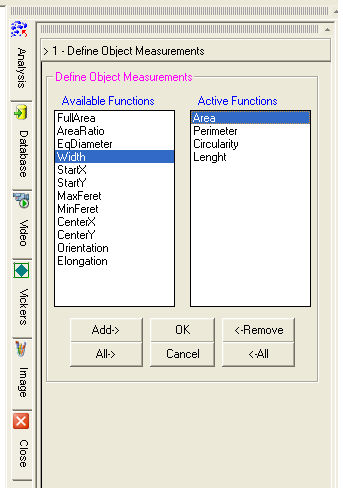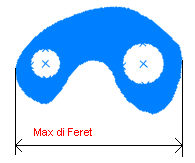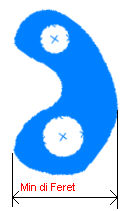 DEFINe
object measurements
DEFINe
object measurementsAllows you to select the measurement functions. The available functions are the following:
Perimeter, Area, Full Area, Area Ratio, Equivalent Diameter, Circularity, Length, Width, Horizontal Coordinate of Object Boundary StartX, Vertical Coordinate of Object Boundary StartY , Maximum and Minimum Feret, Coordinates of the Center of Mass, Orientation and Elongation.
Add-> inserts the selected function in the list of the active functions.
All-> inserts all the available functions in the list of the active functions.
<-Remove deletes the selected function from the list of the active functions.
<-All deletes all the functions from the list of the active functions.
OK confirms and saves the selection.
Perimeter
The perimeter of each object is calculated according to the following formula:
Area
The area of each object is calculated thus:
If the Fill All switch is not selected:
Area = Number of pixels in the object * value of area calibration
Otherwise:
Area = (Number of pixels in the object + number of pixels in holes) * value of area calibration
![]() Circularity is calculated using
the Area obtained with this function.
Circularity is calculated using
the Area obtained with this function.
Full Area
The full area of each object is calculated thus:
Full Area = (Number of pixels in the object + number of pixels in holes) * value of area calibration
Area Ratio
The Area Ratio is the ratio of the total area of all analyzed objects to the measured area.
Area Ratio = Total area of objects / Measured area
![]() The measured area can be: the
whole image or a portion of the image or areas with shapes defined by
the user.
The measured area can be: the
whole image or a portion of the image or areas with shapes defined by
the user.
Equivalent Diameter
It is the diameter of a circle with area equivalent to that of the object. It is calculated thus:
Equivalent Diameter = Sqrt (4 * Area / PI)
Circularity
Circularity indicates how similar the shape of the object is to the shape of a circle with equivalent area. It is calculated thus:
Circularity = 4 * PI * Area / (Perimeter*Perimeter)
If the analyzed object is a circle, circularity will be equal to 1.
Equivalent Length
The equivalent length is calculated thus:
Length = (Perimeter + Sqrt(Abs(Perimeter * Perimeter - 16 * Area ))) / 4
If the analyzed object is a rectangle, the equivalent length is equal to the longer side.
![]() Calculation of the equivalent
length is useless if objects have a shape greatly dissimilar from that
of a rectangle.
Calculation of the equivalent
length is useless if objects have a shape greatly dissimilar from that
of a rectangle.
Equivalent Width
The equivalent width is calculated thus:
Width = (Perimeter - Sqrt(Abs(Perimeter * Perimeter - 16 * Area ))) / 4
If the object of analysis is a rectangle, the equivalent width is equal to the shorter side.
![]() Calculation of the equivalent
width is useless if objects have a shape greatly dissimilar from that
of a rectangle.
Calculation of the equivalent
width is useless if objects have a shape greatly dissimilar from that
of a rectangle.
StartX
Horizontal coordinate of a pixel on the object boundary. The origin of the axes is the upper right vertex of the image.
StartY
Vertical Coordinate of a pixel on the object boundary. The origin of the axes is the upper left vertex of the image.
Maximum Feret

The maximum Feret is the maximum length of the object's projection onto a plane, obtained by rotating the object around its center of mass. The program searches for the maximum value rotating the object through 5-degree steps.
Minimum Feret

The minimum Feret is the minimum length of the object's projection onto a plane, obtained by rotating the object around its center of mass. The program searches for the minimum value rotating the object through 5-degree steps.
Horizontal (X) Coordinate of the Center of Mass
The coordinate of the center of mass is expressed according to the current calibration. The origin of the axes is the upper right vertex of the image. The horizontal axis is the x-axis.
Vertical (Y) Coordinate of the Center of Mass
The coordinate of the center of mass is expressed according to the current calibration. The origin of the axes is the upper left vertex of the image. The vertical axis is the y-axis.
Orientation
Orientation is the angle at which Feret's diameters have their maximum.
Elongation
The value of elongation is the ratio of maximum Feret to minimum Feret.